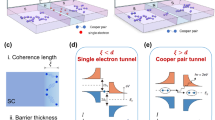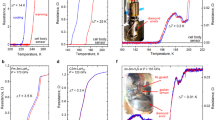Abstract
One of the biggest puzzles concerning the cuprate high temperature superconductors is what determines the maximum transition temperature (T c,max), which varies from less than 30 to above 130 K in different compounds. Despite this dramatic variation, a robust trend is that within each family, the double-layer compound always has higher T c,max than the single-layer counterpart. Here we use scanning tunneling microscopy to investigate the electronic structure of four cuprate parent compounds belonging to two different families. We find that within each family, the double layer compound has a much smaller charge transfer gap size (Δ CT), indicating a clear anticorrelation between Δ CT and T c,max. These results suggest that the charge transfer gap plays a key role in the superconducting physics of cuprates, which shed important new light on the high T c mechanism from doped Mott insulator perspective.




Similar content being viewed by others
References
Lee PA, Nagaosa N, Wen XG (2006) Doping a Mott insulator: physics of high-temperature superconductivity. Rev Mod Phys 78:17–85
Anderson PW (1997) Princeton series in physics. Princeton University Press, Princeton
Damascelli A, Hussain Z, Shen ZX (2003) Angle-resolved photoemission studies of the cuprate superconductors. Rev Mod Phys 75:473–541
Armitage NP, Fournier P, Greene RL (2010) Progress and perspectives on electron-doped cuprates. Rev Mod Phys 82:2421–2487
Fradkin E, Kivelson SA, Tranquada JM (2015) Colloquium: theory of intertwined orders in high temperature superconductors. Rev Mod Phys 87:457–482
Timusk T, Statt B (1999) The pseudogap in high-temperature superconductors: an experimental survey. Rep Prog Phys 62:61–122
Eisaki H, Kaneko N, Feng DL et al (2004) Effect of chemical inhomogeneity in bismuth-based copper oxide superconductors. Phys Rev B 69:064512
Reynolds CA, Serin B, Wright WH et al (1950) Superconductivity of isotopes of mercury. Phys Rev 78:487
Maxwell E (1950) Isotope effect in the superconductivity of mercury. Phys Rev 78:477
Uemura YJ, Luke GM, Sternlieb BJ et al (1989) Universal correlations between T c and n s/m* (carrier density over effective mass) in high-T c cuprate superconductors. Phys Rev Lett 62:2317–2320
Homes CC, Dordevic SV, Strongin M et al (2004) A universal scaling relation in high-temperature superconductors. Nature 430:539–541
Emery VJ (1987) Theory of high-T c superconductivity in oxides. Phys Rev Lett 58:2794–2797
Zaanen J, Sawatzky GA, Allen JW (1985) Band gaps and electronic structure of transition-metal compounds. Phys Rev Lett 55:418–421
Zhang FC, Rice TM (1988) Effective Hamiltonian for the superconducting Cu oxides. Phys Rev B 37:3759–3761
Weber C, Yee C, Haule K et al (2012) Scaling of the transition temperature of hole-doped cuprate superconductors with the charge-transfer energy. Europhys Lett 100:37001
Meng J, Liu G, Zhang W et al (2009) Growth, characterization and physical properties of high-quality large single crystals of Bi2(Sr2−x La x )CuO6+δ high-temperature superconductors. Supercond Sci Technol 22:045010
Sun XF, Ono S, Zhao X et al (2008) Doping dependence of phonon and quasiparticle heat transport of pure and Dy-doped Bi2Sr2CaCu2O8+δ single crystals. Phys Rev B 77:094515
Ye C, Cai P, Yu R et al (2013) Visualizing the atomic-scale electronic structure of the Ca2CuO2Cl2 Mott insulator. Nat Commun 4:1365
Ruan W, Tang P, Fang A et al (2015) Structural phase transition and electronic structure evolution in Ir1−x Pt x Te2 studied by scanning tunneling microscopy. Sci Bull 60:798–805
Zenitani Y, Inari K, Sahoda S et al (1995) Superconductivity in (Ca, Na)2CaCu2O4C12, The new simplest double-layer cuprate with apical chlorine. Phys C 248:167–170
Pothuizen JJM, Eder R, Hien NT et al (1997) Single hole dynamics in the CuO2 plane at half filling. Phys Rev Lett 78:717–720
Ronning F, Kim C, Feng DL et al (1998) Photoemission evidence for a remnant fermi surface and a d-wave-like dispersion in insulating Ca2CuO2Cl2. Science 282:2067–2072
Peng Y, Meng J, Mou D et al (2013) Disappearance of nodal gap across the insulator-superconductor transition in a copper-oxide superconductor. Nat Commun 4:2459
Zhang Y, Hu C, Hu Y et al (2016) In situ carrier tuning in high temperature superconductor Bi2Sr2CaCu2O8+δ by potassium deposition. Sci Bull 61:1037–1043
Feenstra RM (1994) Tunneling spectroscopy of the (110) surface of direct-gap III–V semiconductors. Phys Rev B 50:4561–4570
Feenstra RM, Stroscio JA (1993) Scanning tunneling microscopy. Kaiser WJ, Stroscio JA (eds) Academic Press, San Diego
Zhong Y, Wang Y, Han S et al (2016) Nodeless pairing in superconducting copper-oxide monolayer films on Bi2Sr2CaCu2O8+δ . Sci Bull 61:1239–1247
Pan SH, O’Neal JP, Badzey RL et al (2001) Microscopic electronic inhomogeneity in the high-T c superconductor Bi2Sr2CaCu2O8+x . Nature 413:282–285
Lang KM, Madhavan V, Hoffman JE et al (2002) Imaging the granular structure of high-T c superconductivity in underdoped Bi2Sr2CaCu2O8+δ . Nature 415:412–416
Cai P, Ruan W, Peng Y et al (2016) Visualizing the evolution from the Mott insulator to a charge ordered insulator in lightly doped cuprates. Nat Phys 12:1047–1051
Anderson PW (1987) The resonating valence bond state in La2CuO4 and superconductivity. Science 235:1196–1198
Yee CH, Kotliar G (2014) Tuning the charge-transfer energy in hole-doped cuprates. Phys Rev B 89:094517
Yamada I, Belik AA, Azuma M et al (2005) Single-layer oxychloride superconductor Ca2−x CuO2Cl2 with A-site cation deficiency. Phys Rev B 72:224503
Jin CQ, Wu XJ, Laffez P et al (1995) Superconductivity at 80 K in (Sr, Ca)3Cu2O4 + δCl2−y induced by apical oxygen doping. Nature 375:301–303
Hobou H, Ishida S, Fujita K et al (2009) Enhancement of the superconducting critical temperature in Bi2Sr2CaCu2O8+δ by controlling disorder outside CuO2 planes. Phys Rev B 79:064507
Acknowledgments
This work was supported by the National Natural Science Foundation of China and Ministry of Science and Technology of the People’s Republic of China. X.Z. thanks financial support from the Strategic Priority Research Program (B) of the Chinese Academy of Sciences (XDB07020300).
Author information
Authors and Affiliations
Corresponding author
Ethics declarations
Conflict of interest
The authors declare that they have no conflict of interest.
About this article
Cite this article
Ruan, W., Hu, C., Zhao, J. et al. Relationship between the parent charge transfer gap and maximum transition temperature in cuprates. Sci. Bull. 61, 1826–1832 (2016). https://doi.org/10.1007/s11434-016-1204-x
Received:
Revised:
Accepted:
Published:
Issue Date:
DOI: https://doi.org/10.1007/s11434-016-1204-x




